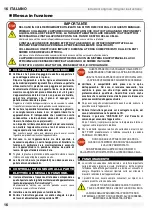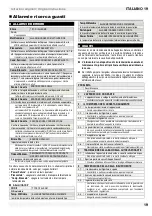
Translation of the original instructions
ENGLISH 7
7
Allarms and Troubleshooting
ALLARMS AND ERRORS
CODE
TYPE OF ALARM
Solutions
Consequences
Multifunction
MULTIFUNCTION INPUT ALARM
Verify what caused the input activation / See the i5 and i6 parameters
Effect established by the i5 parameter / Alarm output activated with u1=3
Pressure Switch
PRESSURE SWITCH ALARM
Verify what caused the input activation / See the i5, i6, i7, i8 and i9 parameters /
Switch the instrument off and on again or disconnect the power supply
The regulators go off / Alarm output activated with u1=3
Cond. Overheated
OVERHEATING CONDENSER ALARM
Verify the condenser temperature / See C6 parameter
Alarm output activated with u1=3
Comp. Blocked
COMPRESSOR BLOCKAGE ALARM
Verify the condenser temperature / See the C7 parameter / Switch the instrument
off and on again: if the condenser temperature is still > parameter C7 when it is
switched on again, disconnect the power supply and clean the condenser
The evaporator compressor and fan go off / Alarm output activated with u1=3
Probe 1 Failure
CHAMBER SENSOR ERROR
Verify the type of sensor / Verify the integrity of the sensor / Verify the
instrument-sensor connection / Verify the chamber temperature
Compressor on or off for 10 m / Defrosting will not be activated / Relè alarm
activated if u1=3 / Door resistors off if u1=4 / Disabling evap. valve if u1=5
Probe 2 Failure
EVAPORATOR SENSOR ERROR
Verify the type of sensor / Verify the integrity of the sensor / Verify the
instrument-sensor connection / Verify the evaporator sensor temperature
Defrosting activated for 30 min with P3=1 / Defrosting at intervals with
P3=1 and d8=2 / The evaporator fan operates in parallel with the
compressor with F0=3 or 4 / Alarm output activated with u1=3
Probe 3 Failure
CONDENSER SENSOR ERROR
Verify the type of sensor / Verify the integrity of the sensor / Verify the
instrument-sensor connection / Verify the condenser sensor temperature
Condenser overheating alarm ("COH") will not be activated / Blocked
compressor alarm ("CSd") will not be activated / Alarm output activated if u1=3
Rtc Failure
CLOCK ERROR
Set the date and time
Defrosting at intervals with d8=3; The HACCP will not provide information
regarding the date and time when the alarm was triggered / The Energy
Saving function is not available in real time / Alarm output activated if u1=3
Defrost Timeout
DEFROST CONCLUDED FOR MAXIMAL
DURATION INSTEAD OF TEMPERATURE
Perform a manual defrost cycle
If the error appear again, call a technical support centre
Once the cause that triggered the alarm is resolved, the instrument
restores normal operation, except for the following alarms that require:
• “
Power Failure
" - any button to be pressed;
• “
Pressure Switch
"- the instrument to be switched off or the power
supply to be disconnected
• “
Comp. Blocked
"- the instrument to be switched off or the power
supply to be disconnected.
HACCP ALARMS
CODE
TYPE OF ALARM
Critical value
Low Temperature
MINIMUM TEMPERATURE ALARM
the minimum chamber temperature during this type of alarm
High
Temperature
MAXIMUM TEMPERATURE ALARM
the maximum chamber temperature during this type of alarm
Door Open
MICRO PORT INPUT ALARM
the maximum chamber temperature during this type of alarm
Power Failure
POWER FAILURE ALARM
the chamber temperature when the power is restored (parameter AA)
FAULT
The following items will help you find possible solutions to some
troubles the unit could be subject to. It is understood that the
information given here does not cover all possible cases.
Whenever a safety device triggers, it means that there is a
malfunction; before resetting it, check and remove the cause.
After making the above checks, if the fault persists contact your after-
sales service. Remember to specify the nature of the defect, the
appliance’s code and serial number (you will find on its nameplate).
PROBLEM
Possible cause
What to do
1
APPLIANCE DOESN’T START
1.1
Appliance isn’t connected to the power supply
Check that the plug is fitted into the mains power supply socket correctly.
2
COMPRESSOR RARELY STOPS
2.1
Room temperature is too high
Ensure proper ventilation to the room
2.2
Refrigerated cabinet condenser is dirty
Check it on a regular basis and clean it thoroughly.
2.3
Low refrigerant charge
Call an authorised technical support centre to find and repair any
leaks and to recharge the compressor with refrigerant.
2.4
Door gaskets do not ensure proper seal
Call an authorised technical support centre to perform the
necessary replacement
2.5
Frost build-up on the evaporator
Do not place hot or high water content foodstuffs into the
appliance and, if needed, perform a manual defrost cycle
2.6
Evaporator motor fan(s) damaged
Call an authorised technical support centre to perform the
necessary replacement
3
OVERFLOWING OF SELF-EVAPORATING CONDENSATE TRAY
3.1
Hot or high-water content foodstuffs are being introduced into the
appliance too often.
Do not introduce hot or high water content foodstuffs into the appliance
3.2
Doors and/or drawers are opened too often.
Pay attention to the conditions of use of your appliance
4
COMPARTMENT TEMPEATURE TOO HIGH
4.1
Refrigerated cabinet condenser is dirty
Check it on a regular basis and clean it thoroughly.
4.2
Feeble aeration of the zone around the technical compartment.
Remove any obstructions for a correct airflow
4.3
Hot air entering the compartment.
Check the correct closure of the door and the gasket to be proper.
If it’s not possible to adjust functioning, call a technical support
centre to perform replacement and regulations
4.4
Frost build-up on the evaporator
Perform a manual defrost cycle
Summary of Contents for KU 725
Page 46: ...45 45 2 70 A 2037 2000 29 2000...
Page 47: ...46 46 R290 50 0 5 5 50 2 6 16A ON STAND BY 1...
Page 48: ...47 47 6 UNLOCK ESC STANDBY 1 1 30 15...
Page 49: ...48 48 16 business economy Nascondi Barra E S 24 149 HACCP HACCP...
Page 51: ...50 50 R290 13 2 8 1 3 50...
Page 58: ...57 57...
Page 59: ...58 58...
Page 60: ...59 59...
Page 61: ...60 60...
Page 66: ...65 65...
Page 67: ...66 66...
Page 68: ...67 67...









































